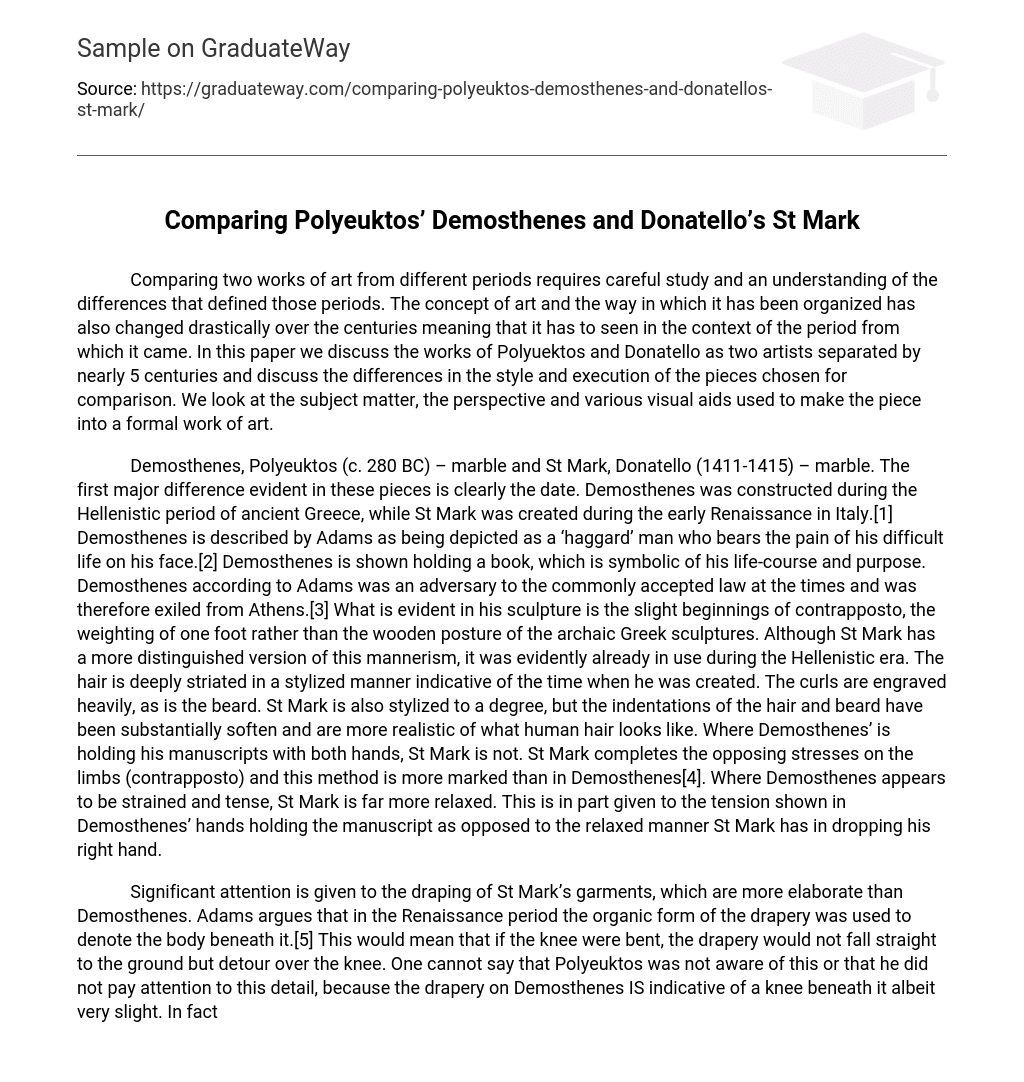Comparing two works of art from different periods requires careful study and an understanding of the differences that defined those periods. The concept of art and the way in which it has been organized has also changed drastically over the centuries meaning that it has to seen in the context of the period from which it came. In this paper we discuss the works of Polyuektos and Donatello as two artists separated by nearly 5 centuries and discuss the differences in the style and execution of the pieces chosen for comparison. We look at the subject matter, the perspective and various visual aids used to make the piece into a formal work of art.
Demosthenes, Polyeuktos (c. 280 BC) – marble and St Mark, Donatello (1411-1415) – marble. The first major difference evident in these pieces is clearly the date. Demosthenes was constructed during the Hellenistic period of ancient Greece, while St Mark was created during the early Renaissance in Italy.[1] Demosthenes is described by Adams as being depicted as a ‘haggard’ man who bears the pain of his difficult life on his face.[2] Demosthenes is shown holding a book, which is symbolic of his life-course and purpose. Demosthenes according to Adams was an adversary to the commonly accepted law at the times and was therefore exiled from Athens.[3] What is evident in his sculpture is the slight beginnings of contrapposto, the weighting of one foot rather than the wooden posture of the archaic Greek sculptures. Although St Mark has a more distinguished version of this mannerism, it was evidently already in use during the Hellenistic era. The hair is deeply striated in a stylized manner indicative of the time when he was created. The curls are engraved heavily, as is the beard. St Mark is also stylized to a degree, but the indentations of the hair and beard have been substantially soften and are more realistic of what human hair looks like. Where Demosthenes’ is holding his manuscripts with both hands, St Mark is not. St Mark completes the opposing stresses on the limbs (contrapposto) and this method is more marked than in Demosthenes[4]. Where Demosthenes appears to be strained and tense, St Mark is far more relaxed. This is in part given to the tension shown in Demosthenes’ hands holding the manuscript as opposed to the relaxed manner St Mark has in dropping his right hand.
Significant attention is given to the draping of St Mark’s garments, which are more elaborate than Demosthenes. Adams argues that in the Renaissance period the organic form of the drapery was used to denote the body beneath it.[5] This would mean that if the knee were bent, the drapery would not fall straight to the ground but detour over the knee. One cannot say that Polyeuktos was not aware of this or that he did not pay attention to this detail, because the drapery on Demosthenes IS indicative of a knee beneath it albeit very slight. In fact the drapery is as it should be considering the way Demosthenes is standing and also bearing in mind that the knee is not strictly ‘bent’ but rather in an un-flexed position. The purpose of both sculptures also has to be taken into account given that the Hellenistic period was one still influenced by the gods and philosophers. St Mark, by contrast is iconographic in his display[6]. He is the really a religious relic chosen to identify a religious place in the same way as Michelangelo’s Pieta or David. Demosthenes is more of a biographical account of a man who made great strides in history but suffered for his cause[7].
Essentially when viewing the two pieces we see many similarities in the raw creation of the pieces. Undoubtedly, St Mark is the more detailed of the two and has clearly undergone the greatest theoretical change. However, Demosthenes is a remarkably accomplished work in terms of its maturity, symbolism and style for a period as early as it was. Sculpture comes in so many forms but it is easy to see the similarities and differences between the two pieces especially when compared to earlier archaic work such as Phaedias and the friezes of the Parthenon.
[1] Adams. Hellenistic Sculpture: p 183 & Early Renaissance p 502.
[2] Ibid p 183.
[3] Ibid.
[4] Adams. Early Renaissance: p 502.
[5] Ibid.
[6] Adams. Why do we study art? P 14.
[7] Ibid p 16.





